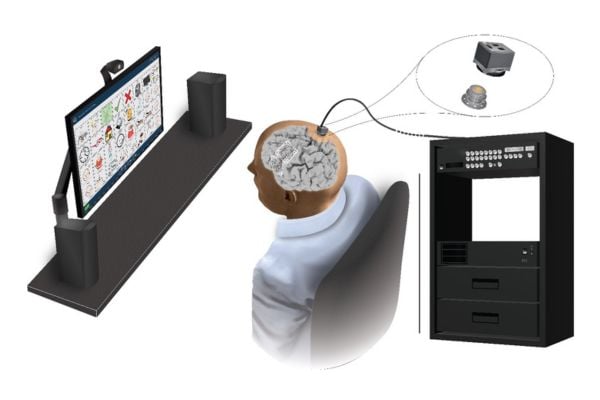A brain-computer interface (BCI) surgically implanted on the brain of an ALS (amyotrophic lateral sclerosis) patient has shown success in translating brain signals into computer commands, according to a new study led by Johns Hopkins researchers.
A brain-computer interface is a device that can translate brain signals into computer commands.
The results of the study, published Oct. 25 in Advanced Science, showed that computer commands were accurately translated from brain activity over a three-month period without requiring the BCI algorithm to be retrained or recalibrated. Shiyu Luo, a graduate student in the Department of Biomedical Engineering, is first author of the paper.
For the study, the BCI (called CortiCom) was surgically implanted on the surface of brain areas responsible for speech and upper limb function in a patient with ALS, a progressive nervous system disease that causes muscle weakness and loss of motor and speech functions. Tim Evans, 62, was diagnosed with ALS in 2014 has developed severe speech and swallowing problems. He can talk slowly, but it’s hard for most people to understand him.
By using the BCI with a special computer algorithm trained to translate his brain signals into computer commands, Evans was able to freely and reliably use a set of six basic commands (up, down, left, right, enter and back) to navigate options on a communication board to control smart devices like room lights and streaming TV applications.
“While past studies on speech BCI have focused on communication, our study addressed the need to control smart devices directly,” says Nathan Crone, M.D., professor of neurology at Johns Hopkins Medicine, senior author of the study. “The BCI accurately recognized a set of 6 commands from neural signals alone, allowing Tim to navigate a communication board and control household devices without needing a language model to fix errors.”
HOW IT WORKS
In the summer of 2022, William Anderson, M.D., Ph.D., M.A., professor of neurosurgery, and Chad Gordon, D.O., professor of plastic and reconstructive surgery, both at the Johns Hopkins University School of Medicine, placed two soft plastic sheets of flat electrodes on the surface of Evans’ brain. The electrode sheets were the size of large postage stamps and were each used to record the electrical signals produced by tens of thousands of brain cells (neurons).
Evans worked with the research team for a few weeks to train the BCI to recognize his unique brain signals, repeating each of the six commands aloud as they appeared on a screen. Once the BCI’s deep-learning algorithm was trained, Evans was asked to issue the same verbal commands to control a communication board in real time, usually for about five minutes every day for three months.
“While Tim’s speech was difficult for most human listeners to understand, the BCI was able to accurately translate his brain activity into computer commands, allowing him to navigate and select items on a communication board at his own pace,” says Shiyu Luo, graduate student in biomedical engineering at The Johns Hopkins University and first author of the paper. “In addition, Tim was able to express how he was feeling or what he wanted.”
Throughout testing, researchers discovered that using signals from both motor and sensory areas of the brain produced the best results. Brain areas related to the movement of the lips, tongue and jaw had the most influence on the BCI’s performance, and stayed consistent over three months of the study, playing a crucial role in making the BCI work well and reliably, says Luo.

